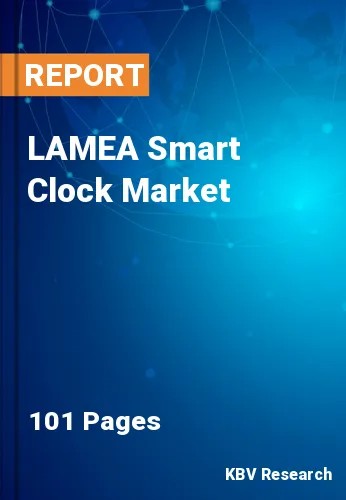The Latin America, Middle East and Africa Smart Clock Market would witness market growth of 18.9% CAGR during the forecast period (2023-2030). In the year 2026, the LAMEA market's volume is expected to surge to 2,454.3 thousand units, showcasing a growth of 21.0% (2023-2030).
Evolving lifestyles, characterized by an increased focus on health and a growing reliance on smart devices, play a key role in shaping the market. As individuals seek tools that seamlessly fit into their daily routines, these have emerged as lifestyle accessories catering to diverse needs. Economic conditions influence consumer purchasing power and, consequently, the demand for non-essential consumer electronics like smart clocks. The market's growth is intertwined with economic stability, and fluctuations in disposable income can impact adoption rates and consumer preferences.
The regulatory environment, including standards for health monitoring features and data privacy concerns, plays a crucial role in shaping the trajectory of the market. Manufacturers must navigate evolving regulations to ensure compliance and build consumer trust in an era of heightened data security and privacy awareness. The market is marked by intense competition among manufacturers vying for market share. The constant quest to innovate, differentiate, and offer unique features defines the competitive landscape. Strategic partnerships, acquisitions, and product diversification are common tactics companies employ to gain a competitive edge in this dynamic market.
Latin American consumers often prioritize aesthetics and interior design in their homes. As per the International Trade Administration, the UAE is the leader in e-commerce among the Gulf Cooperation Council (GCC) states, with e-commerce sales reaching a record $3.9 billion in 2020, representing 10% of total retail sales. E-commerce platforms are accessible 24/7, allowing consumers to shop for smart clocks at any time that suits them. E-commerce platforms frequently run promotional campaigns, discounts, and special offers. Such marketing strategies can attract consumers looking for cost-effective deals, driving the sales of these during promotional periods. Thus, the above aspects will expand the market growth across the region in the upcoming years.
The Brazil market dominated the LAMEA Smart Clock Market by Country in 2022 and would continue to be a dominant market till 2030; thereby, achieving a market value of $56.2 million by 2030. The Argentina market is showcasing a CAGR of 20.1% during (2023 - 2030). Additionally, The UAE market would register a CAGR of 18.4% during (2023 - 2030).
Free Valuable Insights: The Worldwide Smart Clock Market is Projected to reach USD 2.8 Billion by 2030, at a CAGR of 17.2%
Based on Distribution Channel, the market is segmented into Online, Specialty Stores, and Others. Based on countries, the market is segmented into Brazil, Argentina, UAE, Saudi Arabia, South Africa, Nigeria, and Rest of LAMEA.
By Distribution Channel (Volume, Thousand Units, USD Billion, 2019-2030)
By Country (Volume, Thousand Units, USD Billion, 2019-2030)
Our team of dedicated experts can provide you with attractive expansion opportunities for your business.

